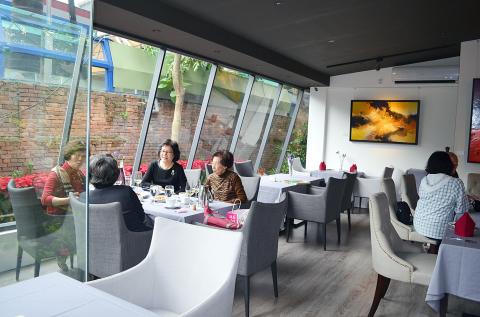In a city with a rich, diverse past like Taipei, serendipity comes in many ways. Tom Chen (陳登壽) owns Jimmy’s Kitchen, a famous Shanghai restaurant with its own history — one that included the original owner fleeing to Taiwan from Shanghai in 1949. But Chen always had another dream.
Chen began work in the service industry at the Grand Hotel, which sent him to Lubeck, Germany to learn bar tending. While there, he became fascinated with the vibrant, raucous atmosphere of salons — places where artists, writers and academics would meet and discuss art and other topics. Chen’s dream was to bring that experience back to Taiwan.
Enter Wolfgang Kroll (1906-1992), a Professor Emeritus in Physics at National Taiwan University (NTU) who grew up in Germany at the height of the Art Deco period. Kroll held the belief that art, literature and science should interrelate.

Photo: Jerome Keating
Kroll may not be a household name with most Taipei residents, but he is well known in the medical and science community because he helped draw international attention to the university, and was responsible for teaching theoretical physics as well as German to generations of physicists and future doctors even after his official retirement.
Kroll, who studied quantum mechanics in Germany under Nobel Prize-winning physicist Werner Heisenberg, emigrated from his home country after Hitler and the Nazi party came to power because one grandparent had Jewish ancestry. With a fascination for Japanese language and culture, Kroll went to Japan in 1937, and then, in 1941, its then-colony Taiwan. One of Kroll’s research papers became the first paper from Taiwan to be published in an international journal.
Until his death in 1992, Kroll lived for half a century in a small Japanese-style house belonging to the university. After his death, the building returned to NTU, which offered it up for development. Still nurturing the dream of a salon, Chen, along with his artist and interior designer-friend Tsai Wen-hsiung (蔡文雄), signed a seven-year lease with the university with an option for renewal. Six months later, the split-level, upscale salon with plenty of natural lighting and artwork, opened to the public as Jimmy’s Garden.
Not strictly a gallery, though art is everywhere, or a restaurant, though you can go there for a meal as well as teatime, Jimmy’s Garden tries to replicate the ambiance of a salon, where he hopes that a new generation of artists, academics and intellectuals will come together over a glass of wine or cup of coffee to discuss and debate current events.
Artists are encouraged to submit an application to display their work at Jimmy’s Garden. Yu Lien-chun’s (余連春) terracotta and metal sculptures are on display until Jan. 31. The salon is open daily from 11am to 9pm and closed on Mondays. 5, Ln 11, Xinsheng S Rd, Sec 3, Taipei City (台北市新生南路三段11巷5號); tel: (02) 2368-1197.

President William Lai (賴清德) yesterday delivered an address marking the first anniversary of his presidency. In the speech, Lai affirmed Taiwan’s global role in technology, trade and security. He announced economic and national security initiatives, and emphasized democratic values and cross-party cooperation. The following is the full text of his speech: Yesterday, outside of Beida Elementary School in New Taipei City’s Sanxia District (三峽), there was a major traffic accident that, sadly, claimed several lives and resulted in multiple injuries. The Executive Yuan immediately formed a task force, and last night I personally visited the victims in hospital. Central government agencies and the

Australia’s ABC last week published a piece on the recall campaign. The article emphasized the divisions in Taiwanese society and blamed the recall for worsening them. It quotes a supporter of the Taiwan People’s Party (TPP) as saying “I’m 43 years old, born and raised here, and I’ve never seen the country this divided in my entire life.” Apparently, as an adult, she slept through the post-election violence in 2000 and 2004 by the Chinese Nationalist Party (KMT), the veiled coup threats by the military when Chen Shui-bian (陳水扁) became president, the 2006 Red Shirt protests against him ginned up by

As with most of northern Thailand’s Chinese Nationalist Party (KMT) settlements, the village of Arunothai was only given a Thai name once the Thai government began in the 1970s to assert control over the border region and initiate a decades-long process of political integration. The village’s original name, bestowed by its Yunnanese founders when they first settled the valley in the late 1960s, was a Chinese name, Dagudi (大谷地), which literally translates as “a place for threshing rice.” At that time, these village founders did not know how permanent their settlement would be. Most of Arunothai’s first generation were soldiers

Among Thailand’s Chinese Nationalist Party (KMT) villages, a certain rivalry exists between Arunothai, the largest of these villages, and Mae Salong, which is currently the most prosperous. Historically, the rivalry stems from a split in KMT military factions in the early 1960s, which divided command and opium territories after Chiang Kai-shek (蔣介石) cut off open support in 1961 due to international pressure (see part two, “The KMT opium lords of the Golden Triangle,” on May 20). But today this rivalry manifests as a different kind of split, with Arunothai leading a pro-China faction and Mae Salong staunchly aligned to Taiwan.